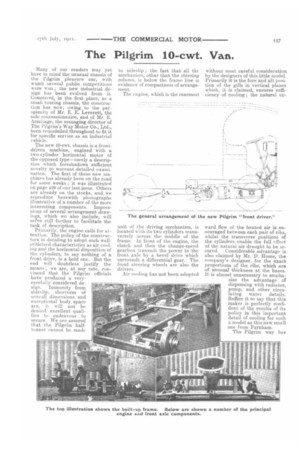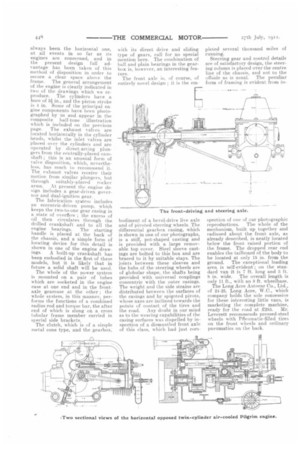The Pilgrim 10-cwt. Van.
Page 13

Page 14

If you've noticed an error in this article please click here to report it so we can fix it.
Many of our readers may yet have in mind the unusual chassis of the Pilgrim pleasure car, with which several public competitions were won ; the new industrial design has been evolved from it. Conceived, in the first place, as a small touring chassis, the construction has now, owing to the perspicuity of Mr. E. E. Leverett, the sole concessionnaire, and of Mr. E. Armitage, the managing director of The Pilgrim's Way Motor Co., Ltd., been remodelled throughout to fit it for specific service as an industrial vehicle.
The new 10-cwt. chassis is a frontdriven machine, engined with a two-cylinder horizontal motor of the opposed type—surely a description which foreshadows sufficient novelty to warrant detailed examination. The first of these new machines has already been on the road for some weeks ; it was illustrated on page 429 of our last issue. Others are already on the stocks, and we reproduce herewith photographs illustrative of a number of the more interesting components. Impressions of several arrangement drawings, which we also include, will sdve still further to facilitate the task of description. Primarily, the engine calls for attention. The policy of the constructors in deciding to adopt such wellcriticised characteristics as air-cooling and the horizontal disposition of the cylinders, to say nothing of a front drive, is a bold one. But the end will doubtless justify the means ; we are, at any rate, convinced that the Pilgrim officials have produced a verycarefully considered de sign. Immunity from sideslip, shortness of overall dimensions and exceptional body space are, it will not be denied, excellent quali ties to endeavour to secure. We are assured that the Pilgrim halftonner cannot be made to sideslip ; the fact that all the mechanism, other than the steering column, is below the frame line is evidence of compactness of arrangement.
The engine, which is the rearmost unit of the driving mechanism, is located with its two cylinders transversely across the middle of the frame. In front of the engine, the clutch and then the change-speed gearbox transmit the power to the front axle by a bevel drive which surrounds a differential gear. The front steering wheels are also the drivers.
Air cooling has not been adopted without most careful consideration by the designers of this little model. Primarily it is the fore and aft position of the gills in vertical planes which, it is claimed, ensures sufficiency of cooling ; the natural up ward flow of the heated air is encouraged between each pair of ribs, whilst the transverse positions of the cylinders enable the full effect of the natural air draught to be secured. Considerable advantage is also claimed by Mr. D. Hume, the company's designer, for the exact proportions of the ribs, which are of unusual thickness at the bases. It is almost unnecessary to emphasize the advantage of dispensing with radiator, pump, and other circulating water details. Suffice it to say that this maker is perfectly confident of the results of its policy in this important detail of cooling for such a model as this new small one from Farnham.
The Pilgrim way has always been the horizontal one, at all events in so far as its engines are concerned, and in the present design full advantage has been taken of this method of disposition in order to secure a clear space above the frame. The general arrangement of the engine is clearly indicated in two of the drawings which we reproduce. The cylinders have a bore of 3i in., and the piston stroke is 4 in. Some of the principal engine components have been photographed by us and appear in the composite half-tone illustration which is included on the previous page. The exhaust valves are located horizontally in the cylinder heads, whilst the inlet valves are placed over the cylinders and are operated by direct-acting plungers from the centrally-placed camshaft ; this is an unusual form of valve disposition, which, nevertheless, has much to recommend it. The exhaust valves receive their motion from similar plungers, but through suitably-placed rocker arms.. At present the engine design includes a gear-driven governor and dual-ignition gear.
The lubrication system includes an eccentric-driven pump, which keeps the two-to-one gear casing in a state of overflow ; the excess of oil then circulates through the drilled crankshaft and to all the engine bearings. The starting handle is placed at the back of the chassis, and a simple form of locating device for this detail is shown in one of the engine draw ings. A built-up crankshaft has been embodied in the first of these models, but it is likely that in future a solid shaft will be used.
The whole of the power system is mounted on a pair of tubes which are socketed in the engine case at one end and in the front. axle gearcase at the other ; the whole system, in this manner, performs the functions of a combined radius rod and torque bar, the after end of which is slung on a cross tubular frame member carried in special side brackets.
The clutch, which is of a simple metal cone type, and the gearbox, with its direct, drive and sliding type of gears, call for no special mention here. The combination of ball and plain bearings in the gearbox is, however, an interesting feature. The front axle is, of course, of entirely novel design ; it is the em bodiment of a bevel-drive live axle and of pivoted steering wheels. The differential gearbox casing, which is shown in one of our photographs, is a stiff, pot-shaped casting and is provided with a large removable top cover. Steel sleeve castings are bolted to this box and are braced to it by suitable stays. The joints between these sleeves and the hubs of the steering wheels are of globular shape, the shafts being provided with universal couplings concentric with the outer casings. The weight and the side strains are distributed between the surfaces of the casings and by spigoted pivots, whose axes are inclined towards the points of contact of the tires and the road, Any doubt in our mind as to the wearing capabilities of the casing surfaces was dispelled by inspection of a dismantled front axle of this class, which had just corn pleted several thousand miles of running. Steering gear and control details are of satisfactory design, the steering column is placed over the centre line of the chassis, and not to the offside as is usual. The peculiar form of framing is evident from in spection of one of our photographic reproductions. The whole of the mechanism, built up together and radiused about. the front axle, as already described, is neatly located below the front raised portion of the frame. The dropped rear end enables the tailboard of the body to be located at only 15 in. from the ground. The exceptional loading area is self-evident ; on the standard van it is 7 ft. long and 3 ft. 8 in. wide. The overall length is only 11 ft., with an 8 ft. wheelbase. The Long Acre Autoear Co., Ltd., of 24-25, Long Acre, W.C., which company holds the sole concession for these interesting little vans, is marketing the complete machine, ready for the road at £285. Mr. Leverett recommends pressed-steel wheels with Pfleumatic-filled tires on the front. wheels and ordinary pneumatics on the back.




















